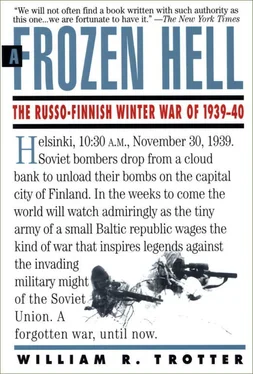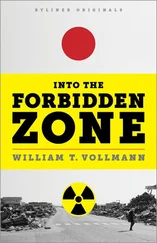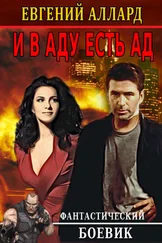Before ice closed the seas, the Red Navy’s submarines torpedoed two Finnish merchant ships and three neutrals in Finnish waterways—one Swede and two Germans—and sank an armed yacht doing escort duty. Mine fields laid by Finnish vessels, on the other hand, sank two Baltic Fleet subs.
CHAPTER 5
“The People’s Republic of Finland”
By far the most interesting sideshow taking place in the early hours of the Winter War was not military at all; it was an act of political vaudeville called “The Terijoki Government,” or “The People’s Republic of Finland.”
Terijoki itself was a small village just inside Finland, the first place of any significance to be “liberated” by the Red Army, only hours after hostilities began. By 1939, the place seems to have become quietly seedy, but fifty years earlier it had been a popular seaside spa for the gentry of St. Petersburg. The Finns fought hard for Terijoki; and when they withdrew they left so many booby traps that the new government must have had a hectic time settling down to business.
To head the new puppet regime, Stalin dragged out O. W. Kuusinen and set him up as “president.” Kuusinen was the most influential of all the old-guard Reds who had fled Finland in 1918. He had been the foremost Red leader during the civil war, and he grew even more doctrinaire after losing the military struggle and fleeing into exile. Kuusinen applied himself diligently to party politics in his new homeland; he did his homework, covered his flanks, came through the purges unscathed, and established for himself a reputation as a leading Marxist-Leninist theoretician. He also took care to ingratiate himself with Stalin from the earliest days of Stalin’s rise to power, and his master had rewarded him by making him secretary general of the Comintern.
Now, overnight—quite literally overnight—he was installed as the head of the “Democratic Government of Finland.” This ascent to high office was marked by a grandiose treaty-signing ceremony between Molotov and Kuusinen. The document began as follows:
…being persuaded that now, through the heroic efforts of the Red Army… there is to be liquidated that true focus of war-infection which the former plutocratic government of Finland had created on the borders of the Soviet Union for the benefit of the Imperialist Powers; And, since the Finnish people have created their own democratic government, which derives its support entirely from the people, the time has come to establish good relations between our countries and, with united forces, to protect the security and inviolability of our nations. [1] Tanner, Väinö, The Winter War (Stanford, Calif.: Stanford University Press, 1957), 101.
The body of the treaty went on cheerfully to grant Stalin every concession he had ever asked of the Finns, with some additional items thrown in for good measure. In return, the whole Finnish land mass was magically rejoined with Soviet Karelia to form “The People’s Republic of Finland.” Broadcasts were soon made in the name of this new government, telling the captive proletariat of “plutocratic Finland” about all the wonderful reforms that would be promulgated after the Red Army had finished liberating them. Kuusinen promised that he would break up all the great landowners’ estates; he also promised the workers an eight-hour day. The workers were not impressed. The eight-hour day had been legislated in Finland twenty-five years earlier, and the government’s land reform program was so far advanced by 1939 that there were only a few hundred estates left in all Finland that measured more than 300 acres. Kuusinen had certainly kept up with things.
To stir up the restive masses, flights of Red bombers roamed rural Finland, dropping tens of thousands of leaflets that bore messages of this sort: “Let us not shoot each other, comrades; let us turn our guns on the common enemy: the White Guard government of Tanner and Mannerheim!!”
Kuusinen was the only person in this new regime that most Finns had ever heard of, and even he was not Stalin’s first choice. That had been a gentleman named Arvo Tuominen, who was more respected inside Finland than the blustery Kuusinen. Tuominen was away in Stockholm on party business when he received a telegram from Moscow inviting him back to head up the new government. The message plunged Tuominen into an agony of indecision, robbing him of several nights’ sleep. He later described the experience in a letter to a friend:
All during that struggle, Evil whispered in my ear: just think what a position you’d get! Just think what a marvelous opportunity it would be to settle old scores!… but to each tempting question, my mind gave a clear answer: it would be wrong, it would be criminal… and behind this, it was not a picture of the free rule of the people, a glorious and happy life, which appeared to me as a result of this… war, but the memory of hundreds of good friends who, as gaunt human ruins, imprisoned and in slave labor, had dug canals through Russia’s endless wilderness. [2] Goodrich, 52.
Tuominen did not wish to be an informer or a traitor; he was still, at heart, a good Communist. He did not reveal the Soviet invasion plans he was now privy to, but he did contact underground cells in Finland and order each man among them to act as his conscience bade him act, thus formally absolving them of any responsibility to Moscow. Then he burned his files and went into hiding for the duration of the conflict.
Kuusinen seems seriously to have believed that the class struggle of 1918 would spontaneously reignite at the sound of his rallying cry. It did not. For most working-class Finns, national pride had long since replaced Marxist allegiance, and a massive foreign invasion unified the nation as nothing else possibly could have, rendering all past squabbles irrelevant. No one could think of oneself any more as just a Communist or just a Social Democrat; now one was simply a Finn. As one working-class novelist put it: “A few weeks ago, I would have put the word Fatherland in quotation marks, but not any more.” [3] Jutikkala, Eino, A History of Finland (New York: Praeger, 1962), 233.
The whole Kuusinen charade was not without its comic-opera aspects. The crowning touch was the creation of something called the “Finnish National Army,” ostensibly made up of pro-Communist Finns who had volunteered to fight alongside their Red Army comrades for the homeland’s liberation. The whole atmosphere surrounding the Kuusinen business makes it impossible to judge whether anyone anywhere took it seriously. Nor can anyone say for sure whether its troops ever saw combat. It was paraded for the cameras on one or two occasions, and eyewitnesses state that there were no more than a thousand men on display.
Even the Russian press never claimed that the Finnish National Army numbered more than 6,000. Certainly the vast majority of its members were East Karelians and exiled Red Guard veterans (who must have been a bit long in the tooth for combat by this time). Sad to say, its ranks also included some genuine turncoats. The exact number is impossible to determine, but there could not have been many. The biggest Russian POW camp in the war had a population of 600 Finns; during an intense recruiting drive for the Kuusinen army, in December, a total of sixteen men are known to have signed up. That small percentage probably reflects the minuscule participation of Finnish defectors in this shadowy army.
If the rest of the Kuusinen episode were not so colored by surreality, one would think the tales had to be apocryphal, but Finnish sources gleefully recount that the first few members of the Finnish National Army to go on display in Terijoki itself, guarding Kuusinen’s headquarters, were dressed in Charles XIIth uniforms looted from a local museum.
Читать дальше












